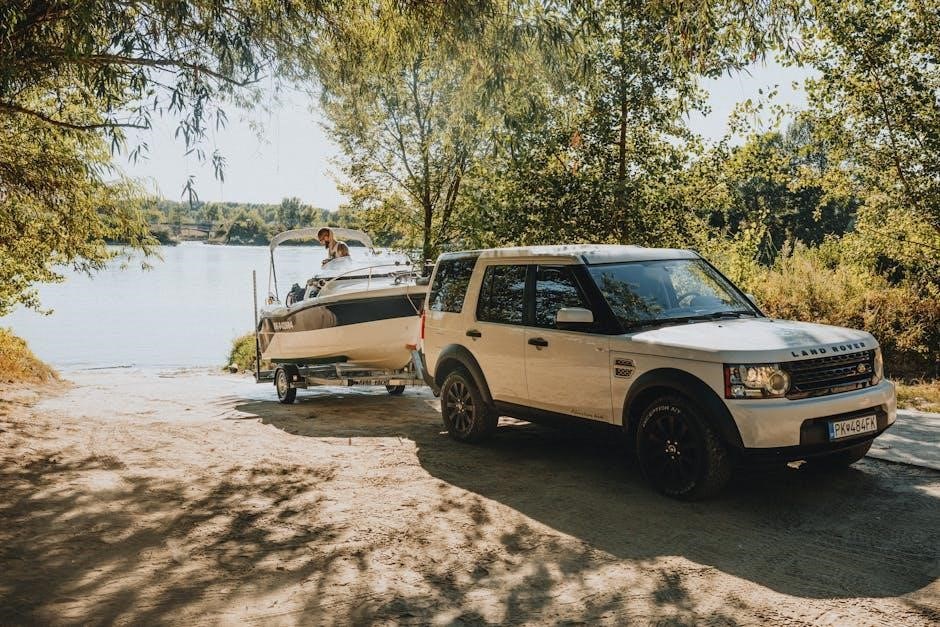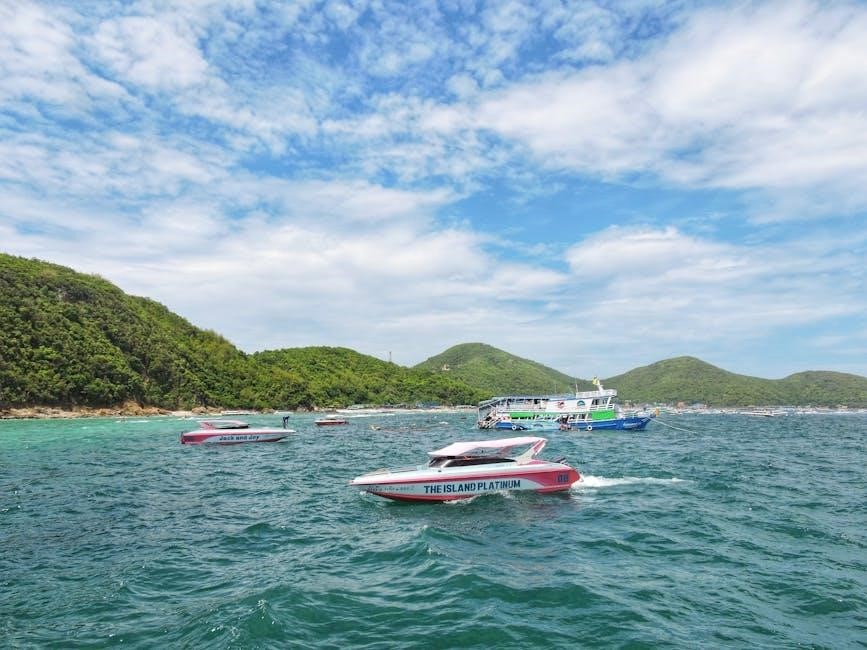Boat trailer guide-ons are essential accessories that enhance the safety and precision of loading and securing your boat onto the trailer, ensuring proper alignment and stability during transport․
What Are Boat Trailer Guide-Ons?
Boat trailer guide-ons are structures or devices attached to a trailer that assist in aligning and centering a boat during loading and unloading․ They typically consist of vertical posts, bunk boards, or rollers and are designed to guide the boat onto the trailer accurately․ Made from durable materials like wood, metal, or PVC-wrapped frames, guide-ons come in various styles, such as bunk-style, roller-style, or post-style, to suit different boat and trailer configurations․ They are adjustable and customizable for optimal performance․
Why Are Guide-Ons Essential for Safe Boat Trailering?
Guide-ons are crucial for ensuring safe and efficient boat trailering․ They provide clear alignment markers, helping to center the boat on the trailer and prevent misalignment during loading and unloading․ This reduces the risk of accidents and damage to both the boat and trailer․ Additionally, guide-ons enhance stability during transport, minimizing boat movement that could affect towing safety․ They also offer protection to the boat’s hull by guiding it away from the trailer frame․ Overall, guide-ons make the trailering process smoother and safer, especially in challenging conditions․

Types of Boat Trailer Guide-Ons
Boat trailer guide-ons come in three primary styles: bunk-style, roller-style, and post-style, each designed to provide alignment support and protection during loading and transport․
Bunk-Style Guide-Ons
Bunk-style guide-ons are wooden boards covered in marine-grade carpet, running along the trailer’s bunk system․ They provide exceptional support and protection for larger boats, ensuring smooth loading and unloading․ Durable and long-lasting, these guide-ons are ideal for heavy-duty use․ Installation involves securing them to the trailer frame with U-bolts or brackets, offering stability and preventing hull damage․ Their carpeted surface reduces friction, making the loading process easier and safer for your boat․
Roller-Style Guide-Ons
Roller-style guide-ons feature smooth-rolling surfaces that assist in centering your boat during loading and unloading․ Designed to reduce friction, they are ideal for trailers with roller systems․ These guide-ons are versatile, suitable for various boat types, including ski boats and pontoons․ They offer easy adjustment and durable construction, ensuring long-lasting performance․ Their sleek design enhances loading precision while protecting your boat’s hull from damage, making them a practical choice for boat owners seeking efficient trailering solutions․
Post-Style Guide-Ons
Post-style guide-ons are tall, vertical structures mounted on the trailer frame, providing clear visual markers for aligning your boat․ They are often PVC-wrapped for durability and feature adjustable uprights to accommodate various boat sizes․ These guide-ons are ideal for enhancing visibility during loading, especially in low-light conditions․ Their simple design makes them easy to install and customize, offering a practical solution for boat owners seeking reliable trailer guidance without the need for complex systems․

Key Features of Boat Trailer Guide-Ons
Boat trailer guide-ons feature durable materials, adjustable designs, and compatibility with various trailer frames, ensuring secure and precise boat alignment during loading and transport․
Adjustability and Customization Options
Boat trailer guide-ons offer exceptional adjustability, allowing precise alignment with your boat’s hull for safe loading․ Customization options include multiple mounting locations, adjustable heights, and interchangeable hardware, ensuring compatibility with various boat sizes and trailer frames․ Many models feature U-bolt attachments and predrilled holes for easy installation․ This adaptability enhances safety and ease of use, making guide-ons suitable for different boat types, from small fishing boats to larger pontoons or sailboats․
Durability and Material Quality
Boat trailer guide-ons are crafted from durable materials like rustproof galvanized steel and marine-grade carpet to withstand harsh marine environments․ High-quality materials ensure longevity and resistance to corrosion, protecting both the guide-ons and your boat․ Sturdy uprights and frames provide reliable support, while protective coverings like PVC piping enhance durability․ This construction ensures guide-ons remain functional and secure, even under heavy use and challenging conditions․
Compatibility with Different Trailer Frames
Boat trailer guide-ons are designed to fit various trailer frames, including 1․5×4, 2×4, and 3×3 inch frames, using U-bolt attachments for secure mounting․ Adjustable designs allow compatibility with both bunk-style and roller-style trailers, ensuring versatility․ Some guide-ons are predrilled for specific boat types, like Lund boats, eliminating the need for drilling․ Universal models accommodate multiple trailer configurations, making them adaptable to different setups and ensuring a perfect fit for various boat and trailer combinations․

How to Choose the Best Boat Trailer Guide-Ons

Assess your boat size, trailer type, and loading style to select guide-ons that offer durability, adjustability, and compatibility with your specific setup for optimal performance․
Factors to Consider for Your Boat and Trailer

When selecting guide-ons, consider your boat’s size, weight, and hull type, as well as the trailer’s frame style and material․ Assess whether you prefer bunk-style, roller-style, or post-style guide-ons based on your loading method․ Durability and adjustability are crucial, with rust-resistant materials like galvanized steel being ideal․ Ensure compatibility with your trailer’s frame dimensions and choose brands known for reliable performance․ Customization options, such as height and width adjustments, can enhance functionality․
Top Brands and Products on the Market
Top brands like CE Smith and Vevor offer high-quality guide-ons․ CE Smith’s Post-Style and Bunkboard models are known for durability and easy installation․ Vevor’s adjustable guide-ons fit various trailers, enhancing loading precision․ These brands provide rust-resistant materials, ensuring longevity․ Their products are highly rated by boat owners for reliability and performance․

Installation and Mounting Guide-Ons
Installation involves securing guide-ons to the trailer frame using U-bolts or brackets, ensuring proper alignment with the boat’s hull for safe and precise loading․
Step-by-Step Installation Process
Begin by determining the type of guide-ons and their mounting locations on the trailer frame․ Position the brackets or U-bolts according to the manufacturer’s instructions, ensuring proper alignment with the boat’s hull․ Drill holes if necessary and secure the guide-ons tightly․ Adjust the height and angle to fit your boat’s specific dimensions, ensuring they are level and evenly spaced․ Finally, test the alignment by guiding the boat onto the trailer to confirm proper fit and functionality․
Tools and Hardware Required
Installing boat trailer guide-ons typically requires a drill, wrench, and screwdriver for securing brackets․ U-bolts, nuts, and washers are essential for mounting, while a measuring tape ensures proper alignment․ For bunk-style guide-ons, marine-grade carpet and wood screws may be needed․ Roller-style guide-ons might require additional hardware like brackets or clamps․ Ensure all components are rust-resistant and durable for long-lasting performance․ Having these tools and hardware ready ensures a smooth and secure installation process․

Maintenance and Repair of Guide-Ons
Regularly inspect guide-ons for damage or wear․ Clean and lubricate moving parts to prevent corrosion․ Replace worn components promptly to maintain optimal functionality and ensure safe trailering experiences always․
Regular Maintenance Tips
Regular maintenance is crucial to ensure the longevity and effectiveness of your boat trailer guide-ons․ Start by inspecting the guide-ons for any signs of rust, corrosion, or physical damage․ Clean them thoroughly, especially after exposure to saltwater, to prevent rust buildup․ Lubricate all moving parts, such as hinges or rollers, to maintain smooth operation․ Adjust the guide-ons as needed to align properly with your boat’s hull․ Additionally, check and tighten all hardware regularly to prevent loosening during transit․ Finally, apply protective coatings or marine-grade sealants to shield the guide-ons from environmental wear and tear․ By following these tips, you can ensure your guide-ons remain reliable and functional for years to come․
Common Repairs and Solutions
Common repairs for boat trailer guide-ons include addressing rust or corrosion by sanding and repainting with marine-grade paint․ Bent posts can often be straightened, while damaged carpeting on bunk-style guide-ons may need replacement․ Worn or loose hardware should be tightened or replaced to maintain stability․ If guide-ons are misaligned, adjust them to ensure proper boat positioning․ Regularly inspect and address these issues to prevent further damage and ensure safe trailering․

Customizing Your Boat Trailer Guide-Ons
Customizing your boat trailer guide-ons can enhance functionality and visibility․ Adding lights or reflectors improves safety, while upgrading hardware boosts durability and performance for a tailored fit․
Adding Lights or Reflectors
Adding lights or reflectors to your boat trailer guide-ons enhances visibility and safety, especially during low-light conditions․ LED lights can be mounted on the guide-on posts to elevate them above water, reducing corrosion and prolonging their lifespan․ Reflectors can also be attached to increase visibility when towing, making it easier for other drivers to see your setup․ This customization not only improves safety but also adds a practical touch to your trailer’s functionality․
Upgrading Hardware for Better Performance
Upgrading the hardware on your boat trailer guide-ons can significantly enhance their performance and durability․ Consider replacing standard brackets with heavy-duty alternatives or switching to stainless steel fasteners for superior corrosion resistance․ Adjustable hardware, such as reinforced U-bolts or high-strength straps, can improve stability and alignment․ These upgrades not only extend the lifespan of your guide-ons but also ensure a safer and more secure towing experience, especially for larger or heavier boats․
Boat trailer guide-ons are essential for safe and precise boat loading, ensuring proper alignment, stability, and protecting your vessel during transport․
Final Tips for Effective Use of Guide-Ons
Always ensure guide-ons are properly adjusted to align with your boat’s hull for smooth loading․ Regularly clean and inspect guide-ons for damage or wear․ Use reflective tape or lights on guide-ons for enhanced visibility, especially in low-light conditions․ Lubricate moving parts to maintain ease of use․ Practice loading your boat onto the trailer in a controlled environment to build confidence․ Proper use of guide-ons will protect your boat and ensure safe, stress-free transport․



